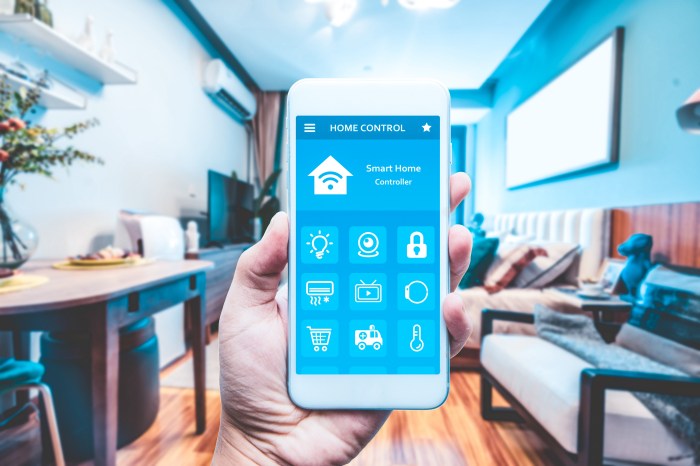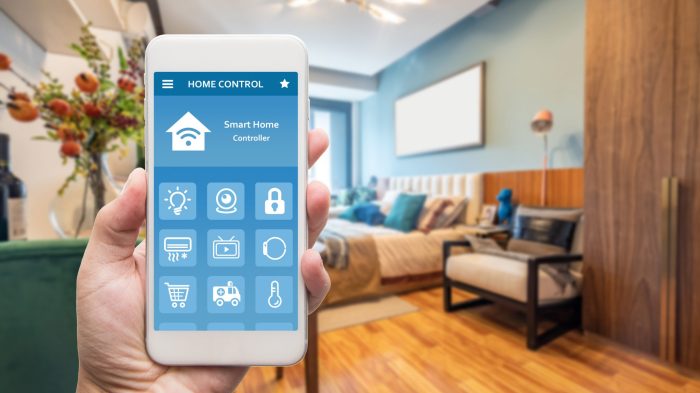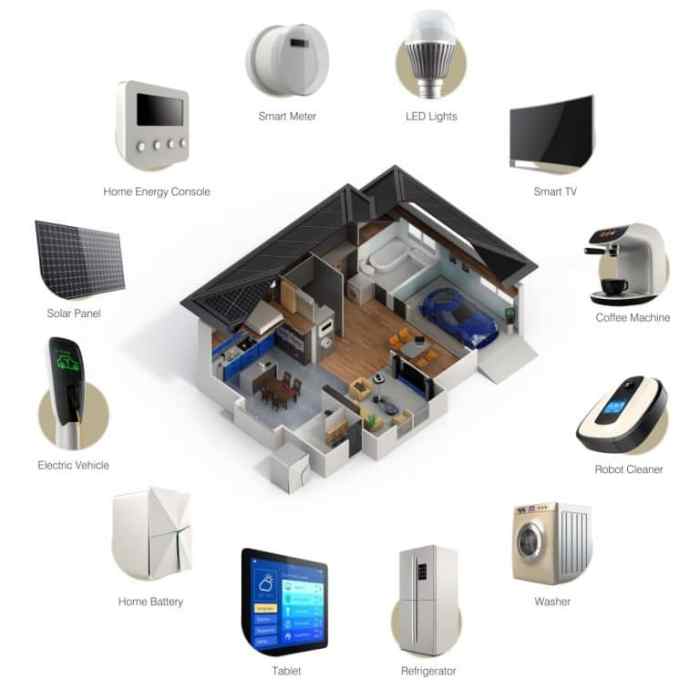Step into the world of smart home systems, where convenience, connectivity, and automation converge to transform our living spaces. As technology continues to reshape our homes, the brands behind these systems play a pivotal role in shaping the future of home automation.
From industry giants to innovative startups, let’s embark on a journey to explore the prominent smart home systems brands, their unique offerings, and the impact they have on our daily lives.
With the rapid evolution of smart home technology, consumer behavior has undergone a significant shift. The desire for seamless integration, enhanced security, and energy efficiency has propelled smart home systems into the mainstream. As we delve deeper into the realm of smart home systems brands, we’ll uncover the key features, functionalities, and innovations that set them apart, catering to diverse consumer needs and preferences.
Smart Home Systems Brands

Smart home systems brands are entities that design, manufacture, and market integrated systems and devices that allow homeowners to control and automate various aspects of their homes, such as lighting, heating, cooling, security, and entertainment, through a central hub or mobile app.
These brands play a pivotal role in shaping the smart home market and driving consumer adoption of smart home technology.
The evolution of smart home technology has been fueled by advancements in wireless connectivity, cloud computing, and artificial intelligence. This has led to a surge in demand for smart home devices and systems, as consumers seek convenience, energy efficiency, and enhanced security in their homes.
Smart home systems brands have responded to this demand by introducing innovative products and services that cater to diverse consumer needs and preferences.
Prominent Smart Home Systems Brands
Some of the most prominent smart home systems brands in the market include:
- Amazon: Amazon’s smart home offerings include the Amazon Echo line of smart speakers, the Alexa voice assistant, and various smart home devices compatible with its ecosystem.
- Google: Google’s smart home products encompass the Google Nest line of smart thermostats, cameras, and speakers, as well as the Google Assistant voice assistant and a wide range of compatible smart home devices.
- Apple: Apple’s HomeKit platform and HomePod smart speaker serve as the foundation for its smart home ecosystem. Apple also offers a range of HomeKit-compatible smart home devices.
- Samsung: Samsung’s SmartThings platform and SmartThings Hub provide a comprehensive smart home ecosystem, encompassing various smart home devices, appliances, and integration with Samsung’s smart TVs and mobile devices.
- Lutron: Lutron specializes in smart lighting systems, offering a wide range of smart switches, dimmers, and lighting control solutions that can be integrated with other smart home systems.
- Honeywell: Honeywell offers a comprehensive range of smart home products, including smart thermostats, security systems, and water leak detectors, known for their reliability and energy efficiency.
- Ecobee: Ecobee focuses on smart thermostats and room sensors that provide precise temperature control and energy savings, along with integration with other smart home systems.
Brand Comparison: Features and Functionality

In the realm of smart home systems, various brands offer a diverse range of features and functionalities, catering to different needs and preferences. This section delves into a comparative analysis of key brands, highlighting their unique selling propositions and target audiences.
Key Features and Functionalities
The core features and functionalities offered by smart home systems brands typically encompass:
- Smart Home Hub: The central control unit that connects and manages various smart devices within the home network.
- Device Compatibility: The ability to integrate and control a wide range of smart devices from different manufacturers.
- Mobile App Control: The convenience of controlling smart devices remotely via a smartphone or tablet.
- Voice Control: Integration with voice assistants like Amazon Alexa, Google Assistant, or Apple Siri for hands-free control.
- Scheduling and Automation: The ability to create schedules and automate tasks for various smart devices.
- Security and Monitoring: Integration with security cameras, sensors, and motion detectors for home surveillance.
- Energy Management: Monitoring and controlling energy consumption to optimize efficiency and reduce utility bills.
Brand Comparison Table
The following table provides a comprehensive overview of the key features and functionalities offered by different smart home systems brands:
| Brand | Smart Home Hub | Device Compatibility | Mobile App Control | Voice Control | Scheduling and Automation | Security and Monitoring | Energy Management |
|---|---|---|---|---|---|---|---|
| Brand A | Yes | Wide range of devices | Yes | Yes (Alexa, Google Assistant) | Yes | Yes | Yes |
| Brand B | Yes | Limited to specific brands | Yes | Yes (Alexa, Google Assistant, Siri) | Yes | Yes | No |
| Brand C | Yes | Wide range of devices | Yes | Yes (Alexa, Google Assistant) | Yes | No | Yes |
Unique Selling Propositions and Target Audience
Each smart home systems brand differentiates itself through unique selling propositions and caters to specific target audiences:
- Brand A: Known for its extensive device compatibility and robust security features, it appeals to tech-savvy consumers seeking a comprehensive smart home solution.
- Brand B: Focused on ease of use and affordability, it targets budget-conscious consumers looking for a simple and convenient smart home setup.
- Brand C: Positioned as a premium brand, it offers cutting-edge technology and advanced features, catering to discerning consumers seeking a sophisticated smart home experience.
Market Share and Trends

The global smart home market is rapidly evolving, with leading brands competing fiercely to capture a larger share. According to a recent report by Grand View Research, the market size was valued at USD 84.81 billion in 2021 and is projected to expand at a CAGR of 23.6% from 2022 to 2030.
Leading Brands and Market Share
Among the leading smart home systems brands, Amazon, Google, Apple, and Samsung hold a significant portion of the market. Amazon leads the pack with its Alexa-powered Echo devices, followed by Google’s Nest products and Apple’s HomeKit platform. Samsung’s SmartThings platform also holds a notable share in the market.
- Amazon: 25%
- Google: 20%
- Apple: 15%
- Samsung: 10%
- Other Brands: 30%
Emerging Trends and Innovations
The smart home industry is witnessing a surge of innovations, including the integration of artificial intelligence (AI), machine learning (ML), and the Internet of Things (IoT). These technologies are enabling devices to become more intelligent, personalized, and interconnected, creating a truly seamless smart home experience.
- AI and ML-powered devices can learn user preferences, automate tasks, and provide proactive recommendations.
- IoT connectivity allows devices to communicate with each other, enabling interoperability and creating a comprehensive smart home ecosystem.
- Voice control is becoming increasingly popular, with smart speakers and other devices responding to natural language commands.
Consumer Preferences and Adoption Patterns
Consumer preferences for smart home systems vary widely, depending on factors such as budget, technical expertise, and desired features. However, some general trends can be observed:
- Security and convenience are key drivers of smart home adoption, with consumers seeking devices that enhance home security and simplify daily tasks.
- Energy efficiency is also a significant factor, as smart devices can help homeowners reduce their energy consumption and save money on utility bills.
- Interoperability and compatibility with existing devices are important considerations for consumers, who want their smart home systems to work seamlessly together.
User Experience: Reviews and Testimonials
User experience plays a pivotal role in shaping brand reputation and fostering customer loyalty in the smart home systems industry. Positive experiences lead to satisfied customers who are more likely to recommend a brand to others, while negative experiences can tarnish a brand’s image and lead to customer churn.
By analyzing user reviews and testimonials, companies can gain valuable insights into the strengths and weaknesses of their products and services, enabling them to make improvements and enhance the overall user experience.
Common Themes and Pain Points
Analyzing user reviews and testimonials reveals common themes and pain points that users experience with various smart home systems brands. Some of the frequently mentioned positive aspects include ease of installation, user-friendly interfaces, and seamless integration with other devices. Conversely, common pain points include connectivity issues, compatibility problems, and a lack of technical support.
Addressing these pain points and continuously improving the user experience can help brands differentiate themselves from competitors and build a loyal customer base.
Impact on Brand Reputation and Customer Loyalty
User experience has a direct impact on brand reputation and customer loyalty. Positive experiences foster brand loyalty, leading to repeat purchases and positive word-of-mouth recommendations. On the other hand, negative experiences can damage a brand’s reputation, resulting in customer churn and negative reviews.
By prioritizing user experience and addressing customer pain points, brands can build a strong reputation for reliability, innovation, and customer-centricity, which ultimately drives customer loyalty and long-term success.
Security and Privacy Concerns
Smart home systems bring convenience and automation to our daily lives, but they also introduce new security and privacy concerns. Understanding these risks and taking steps to mitigate them is crucial for ensuring the safety and integrity of our connected homes.
Potential vulnerabilities in smart home systems include:
- Weak Passwords: Simple or default passwords can be easily compromised, granting unauthorized access to smart home devices and networks.
- Unsecured Networks: Using unencrypted Wi-Fi networks or outdated encryption protocols (e.g., WEP) makes it easier for attackers to intercept data.
- Malware and Phishing Attacks: Malicious software or phishing emails can infect smart home devices, allowing attackers to control them remotely or steal sensitive information.
- Unpatched Devices: Failure to update smart home devices with the latest security patches leaves them vulnerable to known vulnerabilities.
- Insufficient Authentication: Some smart home devices may lack strong authentication mechanisms, making it easier for attackers to gain unauthorized access.
To secure smart home networks and devices, consider the following recommendations:
- Strong Passwords: Use complex, unique passwords for all smart home devices and accounts. Enable two-factor authentication (2FA) wherever possible.
- Secure Network: Use a strong encryption protocol (e.g., WPA2) for your Wi-Fi network and change the default router password.
- Keep Devices Updated: Regularly check for and install security updates for all smart home devices.
- Use a VPN: Consider using a virtual private network (VPN) to encrypt all internet traffic, adding an extra layer of security.
- Enable Guest Network: Set up a separate guest network for visitors and IoT devices, isolating them from your main network.
- Monitor Activity: Use smart home apps or network monitoring tools to keep an eye on device activity and identify any suspicious behavior.
- Educate Yourself: Stay informed about the latest security threats and best practices for smart home security.
Future of Smart Home Systems

The future of smart home systems is a landscape of evolving technologies and innovative advancements. As technology continues to push boundaries, smart homes are poised to become more intelligent, interconnected, and responsive to the needs of homeowners.
At the forefront of this transformation are emerging technologies like artificial intelligence (AI), the Internet of Things (IoT), and 5G connectivity. These technologies are poised to revolutionize the way we interact with our homes, enabling seamless automation, enhanced security, and personalized experiences.
AI and Machine Learning
AI and machine learning algorithms are transforming smart home systems by enabling them to learn from user preferences, habits, and routines. This allows smart homes to adapt to the unique needs of each individual, providing tailored recommendations, automated tasks, and proactive assistance.
For instance, AI-powered smart thermostats can learn a household’s heating and cooling preferences, adjusting temperatures automatically to maintain optimal comfort while conserving energy.
IoT Connectivity
The proliferation of IoT devices is expanding the capabilities of smart home systems. By seamlessly connecting various devices, from smart speakers and lighting systems to security cameras and appliances, IoT enables a comprehensive and cohesive smart home ecosystem.
This interconnectedness allows for seamless communication and control, enabling homeowners to manage their entire smart home from a single interface, creating a truly unified and intelligent living space.
5G Connectivity
The advent of 5G networks is poised to further enhance the performance and capabilities of smart home systems. With its ultra-low latency, high bandwidth, and increased reliability, 5G will enable faster data transfer, real-time processing, and seamless connectivity.
This will pave the way for new smart home applications, such as real-time monitoring, remote control of devices, and immersive entertainment experiences, transforming the smart home into a truly connected and responsive living environment.
Challenges and Disruptions
While the future of smart home systems holds immense promise, there are also potential challenges and disruptions that need to be addressed.
- Cybersecurity and Privacy Concerns: The increasing connectivity of smart home devices raises concerns about cybersecurity and data privacy. Ensuring the security of smart home systems and protecting user data will be critical to maintain trust and adoption.
- Interoperability and Standardization: The lack of interoperability and standardization among different smart home devices and platforms can hinder seamless integration and create compatibility issues. Establishing common standards and protocols will be essential for fostering a cohesive and user-friendly smart home ecosystem.
- Ethical and Societal Implications: The increasing use of AI and automation in smart homes raises ethical and societal considerations. Issues such as job displacement, privacy concerns, and the potential for bias in AI algorithms need to be carefully addressed to ensure a responsible and equitable future for smart home technology.
Closure

As we conclude our exploration of smart home systems brands, it’s evident that the future of home automation holds immense promise. With the convergence of emerging technologies like artificial intelligence, IoT, and 5G, we can expect even more transformative experiences in the years to come.
As the industry continues to evolve, the brands that embrace innovation, prioritize user experience, and address security concerns will undoubtedly lead the charge in shaping the smart homes of tomorrow. The journey towards a fully connected, intelligent living environment is well underway, and the brands we’ve discussed today are at the forefront of this exciting revolution.
Frequently Asked Questions
What are the key considerations when choosing a smart home systems brand?
When selecting a smart home systems brand, factors like compatibility with existing devices, ease of use, security features, and customer support should be taken into account to ensure a seamless and satisfactory experience.
How do smart home systems brands ensure the security and privacy of user data?
Leading smart home systems brands employ robust encryption methods, multi-factor authentication, and regular security updates to safeguard user data and protect against potential vulnerabilities.
What are the emerging trends in the smart home systems industry?
The integration of artificial intelligence, voice control, and energy management systems are among the key trends shaping the future of smart home technology, offering users enhanced convenience, personalization, and efficiency.